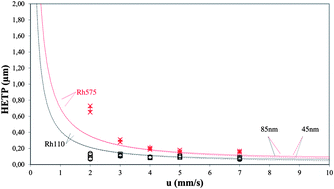We explored the possibility to perform high speed and high efficiency liquid chromatographic separations in channels with a sub-100 nm depth. The mobile phase flow through these nano-channels was generated using the shear-driven flow principle to generate high speed flows which were the equivalent of a 12 000 bar pressure-driven flow. It was found that the ultra-fast mass transfer kinetics prevailing in this range of small channel depths allow to drastically reduce the C-term contribution to band broadening, at least up to the upper speed limit of our current set-up (7 mm s−1 mobile phase velocity), leaving the inescapable molecular diffusion (i.e., B-term band broadening) as the sole detectable source of band broadening. Due to the greatly reduced mass transfer limitations, 50 000 to 100 000 theoretical plates could be generated in the span of 1 to 1.5 seconds. This is nearly two orders of magnitude faster than the best performing commercial pressure-driven UHPLC-systems. With the employed channel depths, we appear to have struck a practical lower limit for the channel miniaturization of shear-driven flows. Despite the use of channel substrates with the highest grades of optical flatness, the overall substrate waviness (on the order of some 5 to 10 nm) can no longer be neglected compared to the etched channel depth, which in turn significantly influenced the local retention factor and band broadening.

You have access to this article
 Please wait while we load your content...
Something went wrong. Try again?
Please wait while we load your content...
Something went wrong. Try again?


 Please wait while we load your content...
Please wait while we load your content...